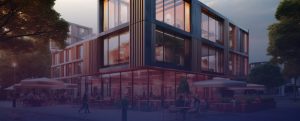From NIMBY to YIMBY: Overcoming Opposition to New Multifamily Development
Several things come to mind that don’t belong in a backyard: Weeds, intruders, and dangerous wildlife are a few. Then there’s development. Whether or not new multifamily housing belongs near someone’s backyard is a more sensitive matter that’s been burdening developers, renters, and homeowners for half a century.
General NIMBY (“not in my backyard”) sentiment originated in the 1970s and has evolved from a political stance to real estate’s most delicate catch-22 affecting the lives of millions of people in the U.S. During that time, NIMBYers met growing opposition from the YIMBY (“yes in my backyard”) crowd, primarily renters, developers, investors, and affordability advocates. By contrast, most NIMBYers are homeowners in suburban or rural areas motivated by their properties’ sentimental and intrinsic value. Some would argue that the NIMBY versus YIMBY debate is not a battle to win but a chronic condition to be managed. Regardless, both sides can’t ignore the glaring problem that pits each against the other: The U.S. desperately needs housing.
How We Got Here
The U.S. multifamily housing market is incredibly underdeveloped. The problem can be traced back to the dot-com bubble and the September 11 attacks shortly after the turn of the century. During the dot-com bubble, widespread investment in technology diverted capital away from traditional investments, including real estate. After the attacks on September 11, many investors sought refuge in tangible assets in suburban and rural areas, viewed as safer than urban areas, causing an imbalance in affordable housing development. Then, when the U.S. faced the housing crisis in 2008, the underdevelopment issue was too far gone.
The issue is a vicious circle. People need housing because the U.S. is so far behind its development target, which places greater stress on the need for more development. In 2023, the U.S. was short over seven million affordable homes for the nation’s 10.8 million extremely low-income families. New multifamily construction quickly declined, with starts down 30% year-over-year in Q4 2023, while the U.S. average asking rent remains increasingly high at $1,713 in Q1 2024. Not only have rents risen, but they have outpaced incomes for two decades. Renter households with an annual income under $30,000 have just $310 a month, an all-time low, after paying for rent. In other words, while personal savings reach a new low, personal debt burden is at its highest.
The nation’s population growth adds another dimension to its lack of housing, as 60% of U.S. counties gained population in 2023. While the number of households increases, older demographics like Baby Boomers show hesitation about selling their homes. If they do sell, they want a price that most buyers aren’t willing to pay for decades-old properties. Most zoning maps and future land use are also outdated, specifically in states like Florida, Tennessee, and Texas, where populations outpace regulations created years ago. Thus, developers look to add density—more units in smaller spaces—to offset years of insufficient development.
Density is one part of a much larger solution to overcoming NIMBY opposition. Supporters of YIMBY must remember that their opponents are driven by sentiments. While a win-win outcome for developers and homeowners is possible, it won’t be achieved by pointing to truth and facts. Instead, YIMBYers can rally more NIMBYers by bridging sentiment to an urgent need: The nation’s communities are sacred, and they must be opened to a deeply lacking population.
Understanding NIMBY Sentiment
Most folks in the NIMBY crowd fear that new, dense multifamily development will deteriorate the value of their homes. Many are incumbent residents of at least 10 years, and some have lived in their homes for 20 to 30 years. They have already made significant returns on their homes regardless of the market. If NIMBYers can’t justify their home value deteriorating—which many may struggle to—they’ll hold onto sentimental value instead. Common fears about new development among the NIMBY crowd include:
- “It will cause more crime.”
- “It will create more traffic.”
- “It will change the neighborhood dynamic.”
- “It won’t blend in well with the neighborhood.”
So far, the appeals have worked on local officials, who have enacted stricter barriers to building in areas where NIMBY sentiment and voting power are strong. Recent NIMBYers are also more sophisticated than before, using tactics unknown to previous generations, such as litigation under the California Environmental Quality Act (CEQA) to stall development in that state. Once a powerful provision for sustainable development, CEQA, which mandates that environmental impact reports be prepared for proposed projects in California, has been largely exploited by NIMBYers to delay unwanted projects.
There is also the matter of animosity toward developers in general. A 2018 survey by UCLA reported that opposition to new development increases by 20% when residents see that the developer is likely to earn a large profit from building. Comparably, opposition increases by just 10% when concerns are traffic-related. It goes without saying that most people are inherently and psychologically change-averse, whether NIMBYer or YIMBYer. Thus, overcoming development fears becomes less a matter of “what” is said, but “how” it’s said. The NIMBY crowd is sentimental and deeply protective, so earning their approval starts with the right delivery.
Recognizing YIMBY Motives
Modern development efforts can often be captured with a common phrase: “Retail follows rooftops.” The idea that activity creates activity has become the driving force behind most YIMBYer-backed development motives. Two recent examples are the completion of Avalon Communities in the Tysons Corner Center in Virginia and New York City’s High Line Park, both known for stimulating additional development in surrounding neighborhoods.
| NIMBY | YIMBY |
| “It will cause more crime.” | The necessary income to pay for new multifamily rents, which on average waver around $2,000, correlates with a well-employed demographic making $75,000 per year or more. |
| “It will create more traffic.” | Typical multifamily tenants, single or recently married residents with no kids, do not impact traffic patterns the same way homeowners do. |
| “It will change the neighborhood dynamic.” | By providing detailed renderings upfront and with plenty of planning, developers can mitigate most NIMBY concerns about changing dynamics. Most of the time, residents are much less concerned about their fears once a project is completed. |
| “It won’t blend in well with the neighborhood.” | A shared development process, in which developers meet with local owners to incorporate historically-minded features into a building’s design, helps YIMBYers gain traction. |
City Manager of Greensboro, North Carolina, and former city planner of Charlotte, North Carolina, Taiwo Jaiyeoba says developers’ biggest mistake is spending too much time and effort getting NIMBYers to accept something they’re against. Instead, developers can focus on rallying more support from their YIMBY cohort at the local level. David Block, a Chicago-area developer and former planner with Evergreen Real Estate Group, describes his approach to community organizing: “Make the case that this is something we need, this is something that we shouldn’t be afraid of, this is something that would benefit the community—and here’s why.”
What Developers Are Doing
The goal shouldn’t be to convert every NIMBYer to a YIMBYer. Many NIMBY concerns are real and rooted in deep sentimental value, while most YIMBY motives are thoughtful and warranted. Instead, overcoming opposition to new development is about developers addressing the nation’s urgent need for more housing with tactical solutions.
Density
One way developers aim to tackle the massive housing shortage in the U.S. is by creating more dense developments. The logic is simple: If two units share a wall, developers don’t need to build two walls. Similarly, if a 40-acre project is slated for 100 homes, a developer can likely build 400 homes by turning the same amount of dirt. Density allows builders to improve their horizontal development costs while delivering higher volumes.
Smaller Units and Lot Frontages
Developers can also build smaller to create more dense projects. One way they do this is by creating smaller units and lot frontages. For example, a unit built in the 1970s may have a 70-foot frontage, while a comparable unit built today may have a 17-foot frontage. Many new projects also opt for smaller, one-car garages instead of a standard two-car space. By saving on square footage, developers can build more units and address the overall shortage of homes in the U.S.
Hope for More Housing
Addressing and overcoming NIMBY sentiment has long been a troublesome part of a developer’s job. Change of any kind inevitably brings pushback—whether it’s change to a neighborhood’s buildings, traffic patterns, or property values—and the historically lengthy processes developers need to follow regarding zoning and land use give their opponents ample time to delay projects or shut them down altogether. Developers can only do so much with density and smaller units; they also need government support. Two recent legislative instances offer hope to the ever-optimistic YIMBY crowd: California’s Executive Directive 1 (ED1) and Florida’s Live Local Act.
California: ED1
Los Angeles is known for its lengthy construction delays due to the city’s exhaustive regulations and code enforcement. Shortly after taking office, Mayor Karen Bass signed Executive Directive 1 in 2023 to tackle the city’s notorious development red tape. Considered an “emergency declaration,” ED1 calls for city departments to expedite 100% affordable projects. The directive’s first year added more than 16,000 affordable units to the city’s pipeline—more than 2020, 2021, and 2022 combined. Encouraging developers to pursue more multifamily projects while cutting costs and expediting the process helps make the “math work,” as one developer explained.
Florida: Live Local Act
In 2023, Florida’s state legislature passed the Live Local Act, which allows developers to bypass local zoning rules and qualify for tax breaks if their projects meet specific housing criteria. Specifically, the measure allows multifamily or mixed-use development in commercial or industrial zones if it provides at least 40% affordable housing for 30 years or more. The Live Local Act reserves affordable units for individuals or families whose annual income is greater than 30% but no more than 60% of the area’s median household income. After its first year, the law faces amendments to clarify language regarding waterfront properties on industrial-zoned land.
Looking Forward
As long as developers build, there will be NIMBY sentiment. And as long as opposition to new multifamily development persists, there will be YIMBY hopefuls. The U.S. is far from closing its housing gap after decades of unfavorable financial and global conditions. If there’s any hope of catching up, it’s in bridging the disparity between NIMBYer nostalgia and YIMBYer motives with some reason, a lot of planning, and one common belief: People need housing.









